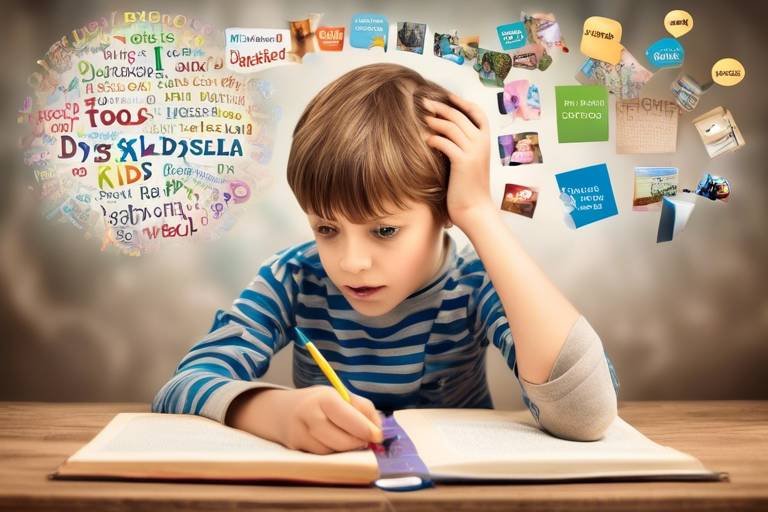Parenting and Education in the Digital Age
In a world where technology is advancing at lightning speed, parenting and education are undergoing a significant transformation. The digital age brings forth a myriad of challenges and opportunities that can profoundly influence children's learning and development. As parents, we find ourselves at a crossroads, navigating through a landscape filled with smartphones, tablets, and endless online resources. How do we adapt our parenting styles to embrace these changes while ensuring our children thrive in this new environment? This article delves into the intricate relationship between technology, parenting, and education, shedding light on how we can harness the power of digital tools to enhance our children's experiences.
Technology has woven itself into the very fabric of our lives, and parenting is no exception. Communication has become more instantaneous, allowing parents to stay connected with their children at all times. However, this constant connectivity can also blur the lines between quality interaction and digital distraction. Have you ever noticed how a family dinner can quickly devolve into everyone staring at their screens instead of engaging with one another? It's a common scenario, and it raises an important question: How do we foster meaningful connections in a digital world?
Moreover, technology influences parenting styles. Some parents embrace it fully, using apps and online resources to enhance their children's learning experiences. Others may feel overwhelmed, struggling to keep up with the latest trends and fearing the potential negative impacts of screen time. Finding a balance is crucial. It’s about using technology as a tool rather than letting it dictate our parenting approach.
Digital learning tools have revolutionized the educational landscape, offering children access to a wealth of information and interactive experiences. From educational apps to online courses, the options are endless. But with great power comes great responsibility. While these tools can enhance learning, they also come with potential drawbacks, such as screen fatigue and the challenge of discerning quality content.
When it comes to educational apps, the market is flooded with choices. Apps like Khan Academy Kids and ABCmouse provide engaging content that can captivate young minds. They offer interactive lessons that make learning fun, turning complex subjects into digestible bites. However, not all apps are created equal. Some may prioritize entertainment over education, leading to a disconnect between play and learning.
So, how do you choose the right educational app for your child? Here are some guidelines:
- Age Appropriateness: Ensure the content is suitable for your child's age group.
- Learning Objectives: Look for apps that align with your child's learning goals.
- Content Quality: Read reviews and check ratings to gauge the app's effectiveness.
Once you've chosen the right apps, it's essential to monitor your child's usage. Setting time limits and encouraging breaks can help prevent burnout and promote a balanced approach to digital learning. Consider using parental control features to keep track of app usage and ensure your child engages with educational content rather than mindless games.
As we embrace the digital age, online safety becomes a paramount concern. The internet is a vast playground, but it can also harbor risks. Parents must equip their children with the knowledge to navigate this space safely. Discuss the importance of privacy, the dangers of sharing personal information, and the need to report any suspicious behavior. Creating an open dialogue about online safety can empower children to make informed decisions.
Finding the right balance between screen time and other activities is essential for healthy development. Too much screen time can lead to physical health issues and hinder social interactions. So, how can parents establish healthy screen time limits? Start by setting clear boundaries. Designate specific times for digital engagement and encourage participation in offline activities, such as sports, reading, or family games. This way, children can enjoy the benefits of technology while also developing essential life skills.
Setting effective boundaries around screen use can be challenging but necessary. Consider implementing a family tech policy that outlines when and where devices can be used. Encourage your children to engage in technology responsibly, reminding them that it's a tool for learning and creativity, not just a means of entertainment.
Fostering offline activities that complement digital learning is crucial. Encourage your children to explore hobbies, join clubs, or participate in sports. These activities not only promote physical health but also enhance social skills and emotional well-being. Remember, the goal is to create a well-rounded individual who can thrive in both the digital and real world.
As we look to the future, emerging trends in education technology will continue to shape the way we approach parenting and learning. Virtual reality, artificial intelligence, and personalized learning experiences are just a few examples of how technology will redefine education. As parents, staying informed about these trends will help us adapt our strategies and support our children in navigating the ever-evolving digital landscape.
Q: How much screen time is appropriate for children?
A: The American Academy of Pediatrics recommends that children aged 2 to 5 should have no more than one hour of high-quality programming each day, while children younger than 2 should avoid screens altogether. For older children, it's essential to set limits based on individual needs and family values.
Q: What are some signs my child is spending too much time on screens?
A: Look for changes in behavior, such as irritability when not using devices, difficulty concentrating, or a decline in academic performance. If you notice these signs, it may be time to reassess their screen time.
Q: How can I ensure my child is using educational apps effectively?
A: Regularly check in with your child about their app usage, engage in discussions about what they are learning, and encourage them to share their experiences with you. This involvement can enhance their learning and make it more meaningful.

The Role of Technology in Parenting
In today's fast-paced world, technology has woven itself into the fabric of our daily lives, and parenting is no exception. The way we communicate, share experiences, and even discipline our children has evolved dramatically due to the influence of digital tools and platforms. It's fascinating to think about how a simple smartphone can reshape the entire parent-child relationship, isn't it? Technology can be a double-edged sword; while it offers incredible opportunities for connection and learning, it also presents unique challenges that require careful navigation.
For instance, consider the way we communicate with our children. Text messages, social media, and video calls have become integral parts of our interactions. Instead of waiting for dinner to discuss the day, parents can now check in with their kids throughout the day with a quick text. This constant connectivity can strengthen bonds, but it can also lead to a sense of detachment when face-to-face conversations are replaced by screens. How do we find the right balance? It's crucial to establish boundaries around technology use to ensure that it enhances rather than detracts from our relationships.
Moreover, technology has transformed parenting styles. Many parents today lean towards a more tech-savvy approach, utilizing apps and online resources to manage their parenting tasks. From scheduling playdates to tracking developmental milestones, technology offers tools that can simplify and enrich the parenting experience. However, this reliance on digital solutions can sometimes lead to over-dependence, where parents might feel overwhelmed by the plethora of options available. It's essential to sift through the noise and find what truly works for your family.
Additionally, the rise of social media has changed the landscape of parenting. Parents often find themselves sharing their experiences online, seeking advice from virtual communities, and even comparing their parenting styles to others. While this can foster a sense of community, it can also create pressure to conform to certain ideals. Are we parenting for our children or for the likes and shares? It's a question worth pondering as we navigate the digital parenting waters.
To illustrate the impact of technology on parenting, let's take a look at some of the key influences:
| Influence | Positive Effects | Negative Effects |
|---|---|---|
| Communication | Improved connectivity, instant updates | Less face-to-face interaction |
| Access to Information | Instant access to parenting resources | Overwhelming amount of conflicting advice |
| Social Media | Community support and shared experiences | Pressure to conform, unrealistic comparisons |
As we embrace technology in our parenting journey, it's vital to remain mindful of its effects on our family dynamics. Are we using technology to foster connections and growth, or are we allowing it to create distance? The key lies in intentionality—choosing how and when to engage with technology in a way that serves our family's unique needs.
In conclusion, the role of technology in parenting is a complex tapestry of benefits and challenges. By being aware of how it impacts our relationships and parenting styles, we can harness its power to create a nurturing environment for our children. As we continue to adapt to this digital age, let’s strive to be present, both online and offline, ensuring that technology serves as a tool for connection rather than a barrier to it.
- How can I balance technology use in my parenting? It's essential to set boundaries around screen time and prioritize face-to-face interactions.
- What are some effective digital tools for parenting? There are many apps available for scheduling, tracking milestones, and even connecting with other parents.
- How do I ensure my child's online safety? Educate your child about online risks, use parental controls, and maintain open communication about their online activities.

Digital Learning Tools
In today's fast-paced world, have become indispensable in shaping children's educational experiences. These tools not only provide access to a wealth of information but also offer interactive and engaging ways for children to learn. Imagine a classroom where traditional textbooks are replaced by tablets filled with interactive content, videos, and games. Sounds exciting, right? However, while the potential benefits of digital learning tools are vast, it's essential to navigate this landscape carefully to maximize their effectiveness.
One of the most significant advantages of digital learning tools is their ability to cater to various learning styles. Whether your child is a visual learner who thrives on graphics and videos or an auditory learner who benefits from podcasts and audiobooks, there's something out there for everyone. These tools can enhance understanding and retention of knowledge by presenting information in multiple formats. But hold on! It's crucial to recognize that not all tools are created equal. Some may lack quality content or may not align with educational standards, which can lead to confusion rather than clarity.
When we talk about digital learning tools, we often think about educational apps, online courses, and interactive websites. Each of these has its unique set of features and benefits. For instance, educational apps can transform mundane learning tasks into exciting challenges through gamification. Children can earn points, unlock levels, or even compete with friends, making learning feel like play. However, parents should be cautious about the apps they choose. Not every app is designed with educational value in mind; some may prioritize entertainment over learning outcomes.
To help parents navigate the vast ocean of digital learning tools, we've compiled a table outlining a few popular options, their features, and potential drawbacks:
| Tool | Features | Potential Drawbacks |
|---|---|---|
| Khan Academy | Free educational resources, personalized learning dashboard | May require parental guidance for younger children |
| Duolingo | Language learning through gamified lessons | Limited depth for advanced learners |
| ABCmouse | Comprehensive curriculum for preschoolers | Subscription-based, may not suit all budgets |
As we delve deeper into the realm of digital learning, we must also consider the importance of monitoring app usage. While these tools can be incredibly beneficial, they can also lead to excessive screen time if not managed properly. It's easy for children to get lost in the digital world, so setting boundaries and encouraging breaks is crucial. Parents should engage with their children about what they're learning and how they're using these tools, fostering a collaborative approach to digital education.
In conclusion, digital learning tools offer exciting opportunities for enhancing children's education. However, it's vital for parents to be actively involved in the process, ensuring that the tools selected are appropriate and beneficial. By doing so, we can help our children harness the power of technology to enrich their learning experiences while still maintaining a healthy balance in their lives.

Educational Apps
In today's fast-paced digital world, have become a vital part of children's learning experiences. These applications offer a unique blend of fun and education, transforming traditional learning methods into interactive adventures. Imagine a classroom where every student is engaged, not just by textbooks but by colorful graphics, sounds, and gamified challenges. This is the reality that educational apps bring to the table, making learning not only effective but also exciting.
With thousands of educational apps available, parents often find themselves navigating a vast sea of options. From math and reading to science and art, there seems to be an app for every subject imaginable. For instance, apps like Khan Academy Kids and ABCmouse provide comprehensive learning experiences tailored for younger audiences, while platforms like Duolingo make language learning accessible and enjoyable for older children. But what makes these apps so appealing? It's the way they combine learning with play, allowing children to absorb information without feeling like they're in a traditional classroom setting.
However, while the benefits of educational apps are clear, there are also some potential drawbacks to consider. Over-reliance on technology can lead to a lack of critical thinking skills and reduced face-to-face interaction. For example, children may become so engrossed in their screens that they miss out on the social aspects of learning, such as group discussions and collaborative projects. Therefore, it's crucial for parents to strike a balance between app usage and traditional learning methods.
To help parents navigate this landscape, here are some key factors to consider when selecting educational apps:
- Age Appropriateness: Ensure the app is suitable for your child's age and developmental stage.
- Learning Objectives: Look for apps that align with your child's educational goals, whether it's improving math skills or enhancing vocabulary.
- Content Quality: Check reviews and ratings to gauge the effectiveness and quality of the app's content.
In conclusion, educational apps can be a powerful tool in enhancing children's learning experiences. They offer a unique way to engage young minds, making education feel more like an adventure than a chore. But as with any tool, moderation and mindfulness are key. By carefully selecting and monitoring app usage, parents can ensure that their children benefit from the best of both worlds: the digital and the traditional.
Q: Are educational apps suitable for all age groups?
A: While many educational apps cater to specific age ranges, it's essential for parents to review the app's content and features to ensure it's appropriate for their child's developmental stage.
Q: How can I monitor my child's app usage?
A: Parents can set time limits on app usage, use built-in parental controls, and regularly discuss app content with their children to maintain a healthy balance.
Q: Do educational apps replace traditional learning methods?
A: No, educational apps should complement traditional learning methods rather than replace them. A balanced approach that includes both digital and offline learning is ideal for a child's development.

Choosing the Right App
In today's fast-paced digital world, selecting the right educational app for your child can feel like searching for a needle in a haystack. With thousands of options available, how do you ensure that the app you choose is not only engaging but also beneficial for your child's learning? The key lies in understanding your child's unique needs and aligning them with the app's features. Here are some essential factors to consider:
First and foremost, age appropriateness is crucial. An app designed for toddlers will differ significantly from one intended for older children. Always check the age recommendations provided by the app developers. Additionally, consider your child's interests. If your child loves dinosaurs, for example, an app that incorporates those themes can make learning more enjoyable and relatable.
Next, focus on the learning objectives. What skills do you want your child to develop? Whether it’s math, reading, or problem-solving, the app should clearly state its educational goals. Look for apps that offer a variety of activities, as this can cater to different learning styles. For instance, some children may thrive with visual aids, while others might prefer auditory instructions.
Another important aspect is content quality. Before downloading, read reviews and check ratings from other parents and educators. Look for apps that are developed by reputable companies or educational institutions. A good quality app should be free from ads and in-app purchases that can distract or confuse young learners. Additionally, consider apps that offer progress tracking, allowing you to monitor your child's development over time.
Moreover, it's essential to think about how the app encourages interaction and engagement. Apps that incorporate gamification elements—like rewards, challenges, and levels—can motivate children to keep learning. However, be cautious; too much gamification can lead to a focus on rewards rather than genuine learning. Striking the right balance is key.
Lastly, don't forget to explore the user interface. An app that is visually cluttered or difficult to navigate can frustrate children and hinder their learning experience. Look for apps with a clean, intuitive design that allows children to explore independently while still being guided.
In summary, choosing the right educational app involves careful consideration of several factors, including age appropriateness, learning objectives, content quality, interactivity, and user interface. By taking the time to evaluate these aspects, you can select an app that not only supports your child's learning journey but also keeps them engaged and excited about education.
- What are the signs of a good educational app? A good educational app should be age-appropriate, have clear learning objectives, offer interactive content, and be designed with a user-friendly interface.
- How much screen time is appropriate for educational apps? The American Academy of Pediatrics suggests that children aged 2 to 5 should have no more than one hour of high-quality programming each day, while children younger than 2 should avoid screens altogether.
- Can educational apps replace traditional learning methods? While educational apps can enhance learning, they should complement traditional methods rather than replace them. A balanced approach is essential for holistic development.

Monitoring App Usage
In today's fast-paced digital world, where apps are just a tap away, monitoring your child's app usage has become more crucial than ever. It’s like being a lighthouse keeper, guiding your little ones through the foggy waters of the internet. The challenge lies not just in keeping an eye on what they’re doing, but also in understanding how these digital experiences impact their development. So, how do we ensure that our children are using these tools wisely without stifling their curiosity and creativity?
First and foremost, communication is key. Talk to your child about the apps they enjoy and what they learn from them. This dialogue not only helps you gauge their interests but also builds trust. You want your child to feel comfortable sharing their online experiences with you, rather than hiding them. Establishing a routine check-in can be beneficial. For instance, set aside a few minutes each week to discuss their favorite apps, what they do on them, and any new features they’ve discovered. This not only keeps you informed but also encourages your child to reflect on their digital choices.
Another effective strategy is to utilize parental control features available on most devices. These tools can help you monitor app usage without being overly intrusive. You can set limits on screen time, restrict access to certain apps, or even receive reports on how much time your child spends on various applications. It’s like having a digital dashboard that gives you insights into your child’s online habits. However, it’s essential to use these tools thoughtfully; they should complement your discussions rather than replace them.
Moreover, consider creating a family media plan. This plan can outline acceptable app usage, screen time limits, and offline activities. By involving your child in this process, you empower them to take responsibility for their digital consumption. They will appreciate having a say in the rules, making them more likely to adhere to them. A typical media plan might look something like this:
| Activity | Screen Time Limit | Offline Alternatives |
|---|---|---|
| Homework-related apps | 1 hour | Reading or outdoor play |
| Games | 30 minutes | Board games or sports |
| Social media | 30 minutes | Family time or hobbies |
Lastly, it’s important to lead by example. Children often mimic their parents’ behavior, so if you’re glued to your phone during family meals or outings, they’re likely to do the same. Show them that while technology is a fantastic tool, there’s a whole world outside of screens waiting to be explored. Balance is the name of the game!
In conclusion, monitoring app usage doesn’t have to be a daunting task. By fostering open communication, utilizing parental controls, creating a family media plan, and setting a good example, you can guide your child toward responsible digital habits. Remember, the goal is not to eliminate technology from their lives but to help them navigate it safely and productively.
Q: How can I tell if an app is appropriate for my child?
A: Check app reviews, ratings, and the age recommendations provided in app stores. Additionally, explore the app yourself to understand its content and features before allowing your child to use it.
Q: What should I do if my child is spending too much time on apps?
A: Have a conversation with your child about their app usage. Discuss the importance of balance and suggest alternative offline activities that they might enjoy.
Q: Are there any apps that can help me monitor my child's usage?
A: Yes, there are several parental control apps available that can help you track app usage, set time limits, and filter content. Examples include Qustodio, Net Nanny, and Norton Family.

Online Safety for Children
In today's digital landscape, ensuring has become more crucial than ever. With the internet being an integral part of our daily lives, it opens up a world of opportunities for learning and exploration. However, it also poses significant risks that can affect children's well-being and security. As parents, it's essential to navigate this complex environment with vigilance and proactive measures.
One of the primary concerns is the exposure to inappropriate content. Children are often curious and may stumble upon websites or videos that are not suitable for their age. To combat this, parents should consider implementing content filters and parental controls on devices. These tools can help restrict access to harmful material, ensuring that children can safely explore the internet without encountering distressing or inappropriate content.
Another critical aspect of online safety is protecting children from cyberbullying. The anonymity of the internet can embolden bullies, making it easier for them to target vulnerable children. It's vital for parents to maintain an open line of communication with their kids about their online interactions. Encourage children to share their experiences and feelings, and remind them that they should always report any bullying incidents. Creating a supportive environment at home can empower children to speak up without fear of judgment.
Moreover, teaching children about privacy is essential in this digital age. Many children may not fully understand the implications of sharing personal information online. Parents should educate their kids about the importance of keeping personal details like their address, phone number, and school information private. A good rule of thumb is to remind children that if they wouldn’t share something with a stranger in person, they shouldn’t share it online either.
To further enhance online safety, parents can utilize various resources and tools designed specifically for this purpose. Here are some effective strategies to consider:
- Set clear guidelines: Establish rules about internet usage, including which sites are acceptable and the duration of screen time.
- Regularly review online activities: Take time to check the websites your children visit and the apps they use.
- Encourage critical thinking: Teach children to think critically about the information they find online and to question its validity.
In addition to these strategies, it's beneficial for parents to stay informed about the latest trends in technology and the internet. By understanding the platforms and apps that children are using, parents can better protect them. Engaging in discussions about online safety and technology can also strengthen the parent-child relationship, making it easier for kids to approach their parents with concerns.
In conclusion, while the internet offers incredible resources for learning and growth, it also comes with its share of dangers. By taking proactive steps to educate children about online safety, setting boundaries, and maintaining open communication, parents can create a safer online environment for their children. Remember, the goal is not to eliminate technology from their lives but to help them navigate it responsibly and safely.
Q1: What are some signs that my child might be experiencing cyberbullying?
A1: Look for changes in behavior, such as increased anxiety, withdrawal from social activities, or reluctance to use their devices. If they seem upset after using the internet, it’s worth investigating further.
Q2: How can I monitor my child's online activity without invading their privacy?
A2: Open communication is key. Discuss your concerns with your child and explain the importance of monitoring. You can also use parental control software that allows for transparency rather than secrecy.
Q3: Are there any specific apps that can help with online safety?
A3: Yes, there are several parental control apps like Qustodio, Norton Family, and Net Nanny that can help monitor and manage your child's online activity effectively.
Q4: How can I educate my child about online privacy?
A4: Have discussions about what constitutes personal information and why it should be kept private. Use real-life examples to illustrate the importance of privacy online.

Balancing Screen Time
In today's fast-paced digital world, finding the right balance between screen time and other activities for children can feel like walking a tightrope. On one hand, technology offers a plethora of educational resources and entertainment options that can enrich our children's lives. On the other hand, excessive screen time can lead to a host of issues, from decreased physical activity to social isolation. So, how can parents navigate this complex landscape to ensure that their children benefit from technology without falling into the trap of overuse?
First and foremost, it's essential to establish clear guidelines regarding screen time. This means not only setting limits on how long children can spend on devices each day but also being intentional about the quality of that screen time. For instance, parents might consider implementing a rule where children can only use screens for educational purposes during the week, reserving weekends for recreational use. This approach can help children understand that not all screen time is created equal and that there is a time for learning and a time for leisure.
To aid in this process, parents can create a screen time schedule that outlines when and how long children can use their devices. This schedule can be displayed prominently in the home, serving as a visual reminder for both parents and children. Here’s a simple example of what that might look like:
| Day | Educational Use | Recreational Use |
|---|---|---|
| Monday | 1 hour | 0.5 hours |
| Tuesday | 1 hour | 0.5 hours |
| Wednesday | 1 hour | 0.5 hours |
| Thursday | 1 hour | 0.5 hours |
| Friday | 1 hour | 1 hour |
| Saturday | 0.5 hours | 2 hours |
| Sunday | 0.5 hours | 2 hours |
Another crucial aspect of balancing screen time is fostering offline activities that engage children physically and socially. Encouraging children to participate in sports, arts and crafts, or family game nights can provide them with fulfilling alternatives to screen time. These activities not only promote physical health but also enhance social skills and strengthen family bonds. For instance, parents might set aside one evening a week for a family board game, creating an opportunity for laughter and connection away from screens.
It's also vital for parents to lead by example. Children often mirror their parents' behaviors, so if parents are glued to their devices, it sends a message that excessive screen time is acceptable. By demonstrating a balanced approach to technology use—such as setting aside specific times for checking emails or scrolling through social media—parents can teach their children the importance of moderation.
Moreover, open communication about technology and its effects is key. Parents should engage their children in discussions about what they are doing online, the content they are consuming, and how it impacts their feelings and interactions. This dialogue can create a sense of trust and understanding, making children more likely to come to their parents with concerns about their screen time or online experiences.
In conclusion, balancing screen time in this digital age is not just about enforcing limits; it’s about creating a holistic approach that combines structure, open communication, and healthy offline activities. By setting clear guidelines, fostering engaging alternatives, leading by example, and maintaining an open dialogue, parents can help their children navigate the digital landscape responsibly. So, are you ready to take charge of your child's screen time and turn it into a positive experience?
- How much screen time is appropriate for children? The American Academy of Pediatrics recommends that children aged 2 to 5 should have no more than one hour of high-quality programming per day, while children aged 6 and older should have consistent limits on the amount of time spent using screens.
- What are some signs of excessive screen time? Signs can include irritability, difficulty sleeping, lack of interest in physical activities, and social withdrawal.
- How can I encourage my child to engage in offline activities? Consider organizing family outings, enrolling them in sports or art classes, or setting up playdates with friends.

Setting Boundaries
In today's fast-paced digital world, setting boundaries around screen time is crucial for fostering a healthy relationship between children and technology. Imagine a world where children can explore the vastness of the internet, but with the safety net of parental guidance. Just like how we wouldn't let our kids roam freely in a busy street, we need to apply the same logic when it comes to their digital adventures.
Establishing clear and consistent boundaries helps children understand the importance of balance. It’s not just about limiting their screen time; it’s about teaching them how to use technology responsibly. One effective strategy is to create a screen time schedule. This can be a simple chart that outlines when and for how long kids can use devices. For instance, you might designate weekends for gaming while keeping weekdays for educational apps. This not only creates a routine but also instills a sense of discipline.
Moreover, it’s essential to involve children in the conversation about screen time limits. Ask them questions like, “How much time do you think is reasonable for gaming each day?” This approach not only empowers them but also opens up a dialogue about their habits and preferences. By making them part of the decision-making process, they are more likely to respect the boundaries you set.
Another effective method is to establish tech-free zones in your home. For example, the dinner table or bedrooms can be designated as areas where screens are not allowed. This encourages family bonding and ensures that children engage in meaningful conversations without distractions. It’s amazing what a simple dinner without screens can do for family dynamics!
While setting boundaries is important, it's equally crucial to model good behavior. Children learn by observing their parents. If they see you glued to your phone during family time, they might feel justified in doing the same. Instead, show them that you can enjoy technology while also valuing offline interactions. This balance is key to fostering a healthy attitude towards screen time.
Lastly, remember that flexibility is also a part of the equation. Life is unpredictable, and sometimes, you might need to adjust the boundaries you’ve set. Whether it’s a rainy day that calls for a movie marathon or a special occasion, being adaptable helps children understand that while rules are important, they can also be adjusted when necessary. This approach not only teaches them about compromise but also about the importance of moderation.
In conclusion, setting boundaries around screen time is not just about restriction; it’s about creating a framework that encourages responsible use of technology. By establishing clear guidelines, involving children in discussions, creating tech-free zones, modeling good behavior, and maintaining flexibility, parents can help their children navigate the digital landscape safely and effectively.
- How much screen time is appropriate for children? The American Academy of Pediatrics suggests that children aged 2 to 5 should have no more than one hour of high-quality programming each day, while older children should have consistent limits that ensure they engage in other healthy activities.
- What are some signs that my child is spending too much time on screens? Look for signs such as irritability when not using devices, difficulty sleeping, or declining academic performance as indicators that it might be time to reassess their screen time.
- How can I encourage my child to engage in offline activities? Introduce them to hobbies like reading, sports, or arts and crafts. Make these activities fun and engaging, so they naturally gravitate towards them instead of screens.

Encouraging Offline Activities
In a world where screens dominate our daily lives, it's essential to **encourage offline activities** for children. Think of it as a refreshing breeze on a hot summer day; it rejuvenates the mind and body. Engaging in offline activities not only provides a break from digital devices but also fosters essential skills that screens simply can't replicate. For instance, when children participate in creative play, they develop their **imagination** and **problem-solving skills**. So, how can we inspire our little ones to step away from their screens and dive into the real world?
First and foremost, consider introducing them to **nature**. A simple walk in the park can turn into an adventure filled with discoveries. Encourage your children to observe the colors of the leaves, listen to the sounds of birds, or even collect interesting stones. This not only enhances their **observational skills** but also connects them to the environment. You could even turn it into a fun scavenger hunt, where they look for specific items in nature, making it both educational and entertaining.
Another fantastic way to promote offline activities is through **arts and crafts**. Set up a designated area at home where your children can unleash their creativity. Provide them with various materials like paper, crayons, paints, and even recycled items. The beauty of arts and crafts is that it encourages **self-expression** and **fine motor skills**. Plus, you can join in on the fun! Imagine the joy of creating something together, whether it's a painted rock or a homemade card for a family member.
Sports and physical activities are also vital in balancing a child's lifestyle. Whether it's kicking a soccer ball around, riding bikes, or even dancing in the living room, physical activity is crucial for their overall development. Not only does it improve their **physical health**, but it also boosts their **mental well-being**. You could create a family challenge, where everyone picks a sport to try out each week. This not only keeps it exciting but also fosters a sense of teamwork and bonding.
Moreover, consider incorporating **reading time** into your daily routine. While e-books are convenient, there's something special about holding a physical book in your hands. Create a cozy reading nook in your home, filled with pillows and blankets, and encourage your children to explore different genres. This can spark their curiosity and imagination, transporting them to different worlds without the need for a screen. To make it more engaging, you could set up a family book club where everyone discusses their favorite stories.
Lastly, don’t forget about the power of **family game nights**. Board games and puzzles can be a delightful way to spend quality time together while also teaching valuable lessons about strategy, patience, and teamwork. You can rotate who gets to choose the game each week, allowing everyone to share their favorites. This not only strengthens family bonds but also creates lasting memories that your children will cherish.
In conclusion, encouraging offline activities is about creating a balanced lifestyle for children. By incorporating nature, arts and crafts, sports, reading, and family games into their routine, you’re not just keeping them away from screens; you’re enriching their lives. Remember, the goal is to make these activities enjoyable and engaging. After all, the best memories are often made away from screens!
- Why are offline activities important for children?
Offline activities help develop essential life skills, promote physical health, and encourage creativity and socialization. - How can I encourage my child to participate in offline activities?
Introduce fun and engaging activities such as nature walks, arts and crafts, sports, reading, and family game nights. - What are some creative offline activities for children?
Consider activities like scavenger hunts, DIY projects, cooking together, or exploring local parks and museums.

The Future of Education
The landscape of education is evolving at a breathtaking pace, and it’s clear that technology is at the forefront of this transformation. As we look ahead, we see a future where learning is more personalized, accessible, and engaging than ever before. Imagine a world where students can learn at their own pace, guided by artificial intelligence that tailors lessons to their unique needs and interests. This shift is not just a dream; it’s already happening, and it’s reshaping the way we think about teaching and learning.
One of the most exciting developments in education technology is the rise of adaptive learning platforms. These platforms utilize algorithms to analyze a student's performance in real-time, adjusting the difficulty of tasks and providing resources that align with their learning style. This approach not only helps students grasp complex concepts but also keeps them motivated by offering challenges that are just right for their skill level. Can you imagine how empowering it would be for a child to have a learning experience that feels custom-made just for them?
Moreover, the integration of virtual and augmented reality (VR and AR) into education is opening up new avenues for immersive learning experiences. Picture this: instead of reading about ancient civilizations in a textbook, students can don VR headsets and walk through the streets of Rome or explore the pyramids of Egypt. This kind of experiential learning not only captivates students' imaginations but also enhances retention by allowing them to interact with the material in a way that traditional methods simply cannot achieve.
However, as we embrace these technological advancements, we must also be mindful of the challenges they bring. The digital divide remains a significant barrier, with many students lacking access to the necessary devices and high-speed internet. As educators and parents, it’s crucial to advocate for equitable access to technology, ensuring that every child has the opportunity to benefit from these innovative learning tools. Without addressing this gap, we risk widening the educational disparities that already exist.
Furthermore, the future of education will likely see a shift towards blended learning environments, where traditional classroom instruction is combined with online learning. This model not only provides flexibility but also allows for a more individualized approach to education. Students can engage with digital content at home while benefiting from face-to-face interactions in the classroom. It’s a win-win situation that prepares children for a world where remote work and digital collaboration are increasingly common.
As we envision the future, it’s essential to consider the role of parents in this new educational landscape. They will need to become active participants in their children's learning journeys, fostering an environment that values both digital and offline experiences. This could mean encouraging kids to explore coding or robotics while also making time for outdoor play and family activities. After all, a well-rounded education is about more than just academics; it’s about nurturing creativity, critical thinking, and social skills.
In conclusion, the future of education is bright, filled with opportunities and challenges alike. By embracing technology while remaining vigilant about equity and balance, we can create a learning environment that prepares our children not just for the next test, but for life in a rapidly changing world. So, let’s get excited about the possibilities and work together to shape an educational landscape that empowers every child to thrive!
- What is adaptive learning? Adaptive learning is a personalized approach to education that uses technology to adjust content and assessments based on a student's individual performance and learning style.
- How can VR and AR enhance learning? Virtual and augmented reality provide immersive experiences that allow students to interact with educational content in a way that traditional methods cannot, leading to better engagement and retention.
- What is blended learning? Blended learning combines traditional face-to-face classroom instruction with online learning, providing a flexible and individualized approach to education.
- How can parents support their children's education in the digital age? Parents can support their children's education by engaging with them in their learning processes, encouraging a balance of digital and offline activities, and advocating for equitable access to technology.
Frequently Asked Questions
- How does technology impact parenting styles?
Technology has dramatically changed the way parents interact with their children. With the rise of social media, instant messaging, and various apps, parents can now communicate more efficiently and stay connected with their kids. However, it also presents challenges, such as finding the right balance between screen time and face-to-face interactions. It's essential for parents to adapt their styles to foster healthy relationships while embracing the benefits of technology.
- What are some effective digital learning tools for children?
There are numerous digital learning tools available that can enhance children's educational experiences. These include educational apps, online courses, and interactive websites designed for various age groups. Some popular options are coding apps, math games, and language learning platforms. However, it's crucial to evaluate each tool's content quality and ensure it aligns with your child's learning objectives.
- How can I choose the right educational app for my child?
When selecting an educational app, consider factors such as your child's age, interests, and learning goals. Look for apps that are engaging, age-appropriate, and provide clear educational value. Reading reviews and checking ratings can also help guide your decision. Don't hesitate to try out a few different apps to see which ones resonate best with your child!
- What strategies can I use to monitor my child's app usage?
Monitoring your child's app usage can be achieved through various strategies. Set specific time limits for app usage, and encourage regular breaks. You can also use parental control features available on devices to restrict access to certain apps and track usage. Open communication about their online activities is vital; encourage them to share their experiences and what they enjoy about the apps they use.
- How can I ensure my child is safe online?
Online safety is crucial in today's digital age. Start by educating your child about the potential risks associated with internet use, such as cyberbullying and privacy concerns. Establish guidelines for safe online behavior, including not sharing personal information and reporting any suspicious activity. Regularly check in with your child about their online interactions and keep the lines of communication open.
- What are some tips for balancing screen time with other activities?
Finding the right balance between screen time and other activities is essential for your child's development. Set clear rules regarding screen time limits and encourage alternative activities, such as sports, reading, or family outings. Creating a daily schedule that includes a mix of digital and offline activities can help establish a healthy routine. Remember, moderation is key!
- How can I encourage my child to participate in offline activities?
Encouraging offline activities can be as simple as setting aside specific times for family games, outdoor play, or arts and crafts. Lead by example—show enthusiasm for these activities and participate alongside your child. You can also introduce them to hobbies that spark their interest, such as gardening or cooking, which can be both fun and educational!
- What trends are shaping the future of education technology?
Emerging trends in education technology include personalized learning experiences, virtual reality (VR) classrooms, and artificial intelligence (AI) tutors. These innovations aim to create more engaging and tailored educational experiences for students. As technology continues to evolve, parents and educators must stay informed about these trends to effectively support children's learning in the digital age.



















